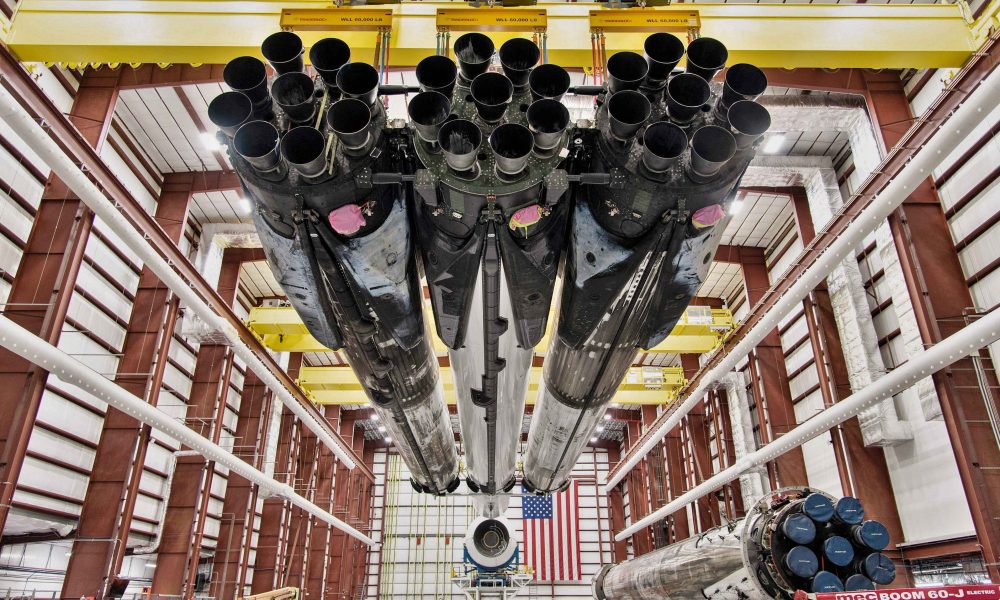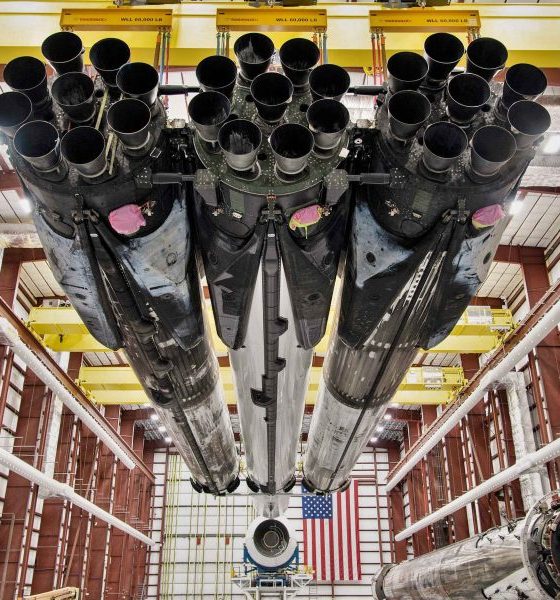

News
No SpaceX Falcon Heavy payload is safe as NASA Psyche mission announces delay
SpaceX’s first dedicated Falcon Heavy launch for NASA has been hit by a seven-week delay after spacecraft engineers discovered a software anomaly during preflight processing.
Named after the exotic metallic asteroid it’s designed to explore, NASA’s Psyche spacecraft completed its journey from the Jet Propulsion Laboratory in Pasadena, California to NASA’s Kennedy Space Center launch facilities in late April. To this day, it’s the first and only Falcon Heavy payload to actually reach Kennedy Space Center since mid-2019. At the time of its arrival, it was somewhat unclear when Falcon Heavy would finally end its three-year launch hiatus or what payload(s) would be atop the rocket for the event.
Three weeks later, both things are still unclear, but now for different reasons.
On May 23rd, Spaceflight Now reported that it had received a written statement from NASA confirming that Psyche’s launch had been delayed from August 1st, 2022 to no earlier than (NET) September 20th “after ground teams discovered an issue during software testing on the spacecraft.” After the spacecraft’s arrival at a Kennedy Space Center payload processing facility, teams have spent the last few weeks combing over Psyche and making sure that it survived the journey without issue. At an unknown point, engineers would have needed to power on the spacecraft’s computers to perform extensive diagnostic tests. It’s also possible that a late build of Psyche’s flight software was being analyzed externally before final installation.
Either way, something went wrong. For the moment, all NASA is willing to say is that “an issue is preventing confirmation that the software controlling the spacecraft is functioning as planned.” Although it does seem to center around software, such a vague statement fails to rule out the possibility of a hardware problem, which could help to better explain why NASA and the spacecraft team rapidly chose to delay Psyche’s launch by more than seven weeks.
For unknown reasons, virtually every near-term Falcon Heavy payload has slipped significantly from its original launch target. Within the last few weeks, USSF-44 – meant to launch as early as June 2022 after years of delays – was “delayed indefinitely.” Delayed from Q3 2020, USSF-52 is now scheduled to launch in October 2022. ViaSat-3, once meant to launch on Falcon Heavy in 2020, is now NET September 2022. Jupiter-3, a record-breaking communications satellite that wasn’t actually confirmed to be a Falcon Heavy launch contract until a few weeks ago, recently slipped from 2021 and 2022 to early 2023.
Only USSF-67, which hasn’t had its official launch target updated in more than a year, is reportedly still on track to launch somewhere within its original launch window (H2 2022). If it actually does launch without delay on a Falcon Heavy rocket in November 2022, it will be quite the outlier. Meanwhile, Psyche’s September 20th delay means that it could now conflict with Falcon Heavy’s ViaSat-3 mission, which must use the same launch pad. More likely than not, ViaSat-3 was already likely to slip into Q4, but the situation exemplifies how agonizing scheduling launches for almost half a dozen chronically-delayed payloads must be for SpaceX.
Meanwhile, SpaceX must also store and maintain nine different Falcon Heavy boosters as they are forced to continue waiting for their long-assigned missions. SpaceX’s entire fleet of operational Falcon 9s – including one Falcon Heavy booster temporarily serving as a Falcon 9 – contains 12 boosters, meaning that more than 40% of all Falcon boosters are currently dead weight.

Elon Musk
Elon Musk’s X will start using a Tesla-like software update strategy
The initiative seems designed to accelerate updates to the social media platform, while maintaining maximum transparency.

Elon Musk’s social media platform X will adopt a Tesla-esque approach to software updates for its algorithm.
The initiative seems designed to accelerate updates to the social media platform, while maintaining maximum transparency.
X’s updates to its updates
As per Musk in a post on X, the social media company will be making a new algorithm to determine what organic and advertising posts are recommended to users. These updates would then be repeated every four weeks.
“We will make the new 𝕏 algorithm, including all code used to determine what organic and advertising posts are recommended to users, open source in 7 days. This will be repeated every 4 weeks, with comprehensive developer notes, to help you understand what changed,” Musk wrote in his post.
The initiative somewhat mirrors Tesla’s over-the-air update model, where vehicle software is regularly refined and pushed to users with detailed release notes. This should allow users to better understand the details of X’s every update and foster a healthy feedback loop for the social media platform.
xAI and X
X, formerly Twitter, has been acquired by Elon Musk’s artificial intelligence startup, xAI last year. Since then, xAI has seen a rapid rise in valuation. Following the company’s the company’s upsized $20 billion Series E funding round, estimates now suggest that xAI is worth tens about $230 to $235 billion. That’s several times larger than Tesla when Elon Musk received his controversial 2018 CEO Performance Award.
As per xAI, the Series E funding round attracted a diverse group of investors, including Valor Equity Partners, Stepstone Group, Fidelity Management & Research Company, Qatar Investment Authority, MGX, and Baron Capital Group, among others. Strategic partners NVIDIA and Cisco Investments also continued support for building the world’s largest GPU clusters.
News
Tesla FSD Supervised wins MotorTrend’s Best Driver Assistance Award
The decision marks a notable reversal for the publication from prior years, with judges citing major real-world improvements that pushed Tesla’s latest FSD software ahead of every competing ADAS system.

Tesla’s Full Self-Driving (Supervised) system has been named the best driver-assistance technology on the market, earning top honors at the 2026 MotorTrend Best Tech Awards.
The decision marks a notable reversal for the publication from prior years, with judges citing major real-world improvements that pushed Tesla’s latest FSD software ahead of every competing ADAS system. And it wasn’t even close.
MotorTrend reverses course
MotorTrend awarded Tesla FSD (Supervised) its 2026 Best Tech Driver Assistance title after extensive testing of the latest v14 software. The publication acknowledged that it had previously criticized earlier versions of FSD for erratic behavior and near-miss incidents, ultimately favoring rivals such as GM’s Super Cruise in earlier evaluations.
According to MotorTrend, the newest iteration of FSD resolved many of those shortcomings. Testers said v14 showed far smoother behavior in complex urban scenarios, including unprotected left turns, traffic circles, emergency vehicles, and dense city streets. While the system still requires constant driver supervision, judges concluded that no other advanced driver-assistance system currently matches its breadth of capability.
Unlike rival systems that rely on combinations of cameras, radar, lidar, and mapped highways, Tesla’s FSD operates using a camera-only approach and is capable of driving on city streets, rural roads, and freeways. MotorTrend stated that pure utility, the ability to handle nearly all road types, ultimately separated FSD from competitors like Ford BlueCruise, GM Super Cruise, and BMW’s Highway Assistant.
High cost and high capability
MotorTrend also addressed FSD’s pricing, which remains significantly higher than rival systems. Tesla currently charges $8,000 for a one-time purchase or $99 per month for a subscription, compared with far lower upfront and subscription costs from other automakers. The publication noted that the premium is justified given FSD’s unmatched scope and continuous software evolution.
Safety remained a central focus of the evaluation. While testers reported collision-free operation over thousands of miles, they noted ongoing concerns around FSD’s configurable driving modes, including options that allow aggressive driving and speeds beyond posted limits. MotorTrend emphasized that, like all Level 2 systems, FSD still depends on a fully attentive human driver at all times.
Despite those caveats, the publication concluded that Tesla’s rapid software progress fundamentally reshaped the competitive landscape. For drivers seeking the most capable hands-on driver-assistance system available today, MotorTrend concluded Tesla FSD (Supervised) now stands alone at the top.
News
Elon Musk’s Grokipedia surges to 5.6M articles, almost 79% of English Wikipedia
The explosive growth marks a major milestone for the AI-powered online encyclopedia, which was launched by Elon Musk’s xAI just months ago.

Elon Musk’s Grokipedia has grown to an impressive 5,615,201 articles as of today, closing in on 79% of the English Wikipedia’s current total of 7,119,376 articles.
The explosive growth marks a major milestone for the AI-powered online encyclopedia, which was launched by Elon Musk’s xAI just months ago. Needless to say, it would only be a matter of time before Grokipedia exceeds English Wikipedia in sheer volume.
Grokipedia’s rapid growth
xAI’s vision for Grokipedia emphasizes neutrality, while Grok’s reasoning capabilities allow for fast drafting and fact-checking. When Elon Musk announced the initiative in late September 2025, he noted that Grokipedia would be an improvement to Wikipedia because it would be designed to avoid bias.
At the time, Musk noted that Grokipedia “is a necessary step towards the xAI goal of understanding the Universe.”
Grokipedia was launched in late October, and while xAI was careful to list it only as Version 0.1 at the time, the online encyclopedia immediately earned praise. Wikipedia co-founder Larry Sanger highlighted the project’s innovative approach, noting how it leverages AI to fill knowledge gaps and enable rapid updates. Netizens also observed how Grokipedia tends to present articles in a more objective manner compared to Wikipedia, which is edited by humans.
Elon Musk’s ambitious plans
With 5,615,201 total articles, Grokipedia has now grown to almost 79% of English Wikipedia’s article base. This is incredibly quick, though Grokipedia remains text-only for now. xAI, for its part, has now updated the online encyclopedia’s iteration to v0.2.
Elon Musk has shared bold ideas for Grokipedia, including sending a record of the entire knowledge base to space as part of xAI’s mission to preserve and expand human understanding. At some point, Musk stated that Grokipedia will be renamed to Encyclopedia Galactica, and it will be sent to the cosmos.
“When Grokipedia is good enough (long way to go), we will change the name to Encyclopedia Galactica. It will be an open source distillation of all knowledge, including audio, images and video. Join xAI to help build the sci-fi version of the Library of Alexandria!” Musk wrote, adding in a later post that “Copies will be etched in stone and sent to the Moon, Mars and beyond. This time, it will not be lost.”








